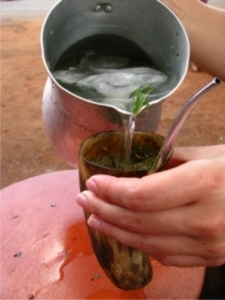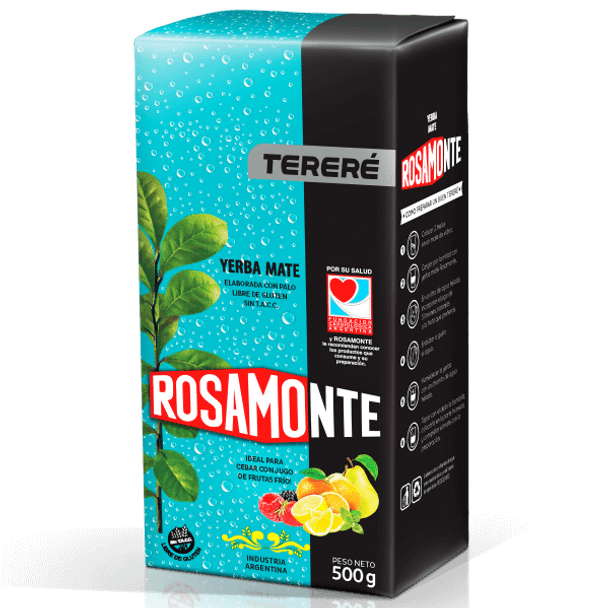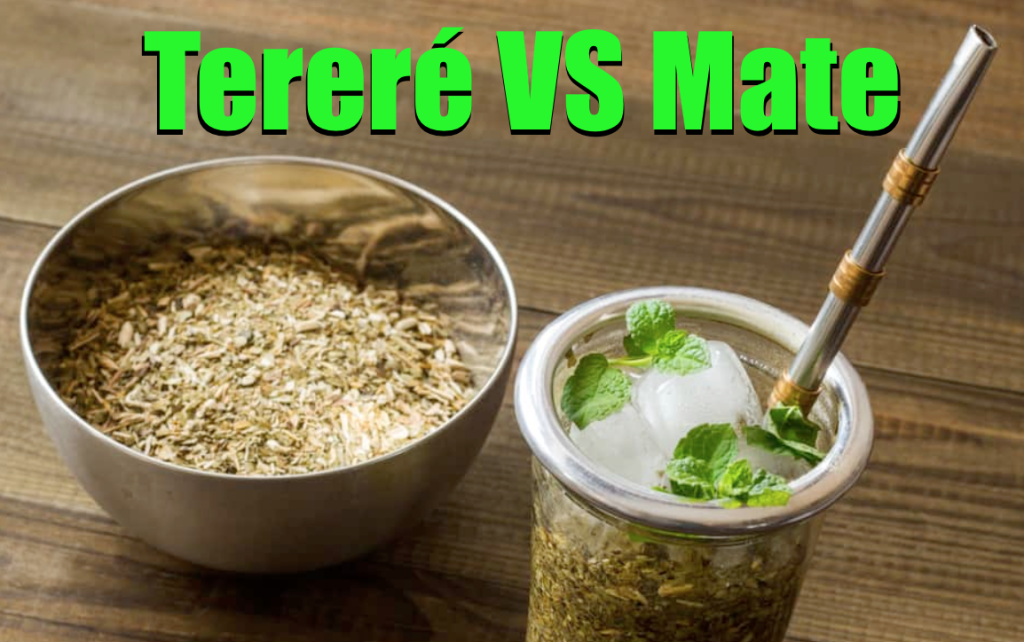What is tereré?
If you drink yerba mate, you’re probably familiar with this word. It’s pronounced teh-reh-REH (don’t forget to roll those r’s). And if you’re new to this tea, it’s easy to be confused by what it is.
The good news though is it’s not confusing at all.
Tereré is a drink just like mate.
In fact, it’s considered the national drink of Paraguay (you’ll find out why in just a minute).
And in today’s post, we’re going to look at what the main differences and similarities are between tereré and mate, and how you can easily start drinking both of them today.
Let’s start!
Tereré VS Mate
To keep it short and simple, tereré is simply mate brewed cold.
That’s it?
Yes, that’s literally the only difference.
So if you have a gourd, bombilla, and bag of yerba at home, you can already start drinking tereré like a Paraguayan. In Paraguay, they prefer tereré over mate because of how hot it is over there. Tereré is akin to lemonade or iced tea in the United States – they drink it to keep cool and refreshed.
Now, although tereré and mate are very similar, there are a few things that are different.
Let’s have a look…
Things Needed For Tereré VS Yerba Mate
Traditionally, tereré is consumed in a guampa (cow horn), whereas yerba mate is consumed in a calabash gourd. But because it’s rare to find guampas nowadays, it’s more commonly consumed in a stainless steel gourd since it helps keep it chilled.

When it comes to bombillas though, there’s no difference. Use anyone you’d like. But a spoon bombilla is always what I prefer.
Now when it comes to yerba mate, there’s a difference.
For tereré, although you can use any brand, maybe with the exception of chimarrão, Paraguayan yerba mate brands (like Pajarito, Selecta, and La Rubia) are traditionally used as they’re meant to be consumed cold. For regular hot mate, however, you can use any type of yerba mate you’d like.
As tereré is becoming more and more popular, yerba mate companies from other regions are also beginning to sell variations of their traditional mate to be designed just for tereré. Two brands from Argentina – Rosamonte Tereré and Pipore Tereré – are good examples.

Other types of yerba mate to be aware of are those that are flavored or are combined with other herbs. Popular brands like CBSe, Kurupi, and Campesino include mint, boldo, catuaba, guarana, ginseng, lemon verbena, and more, while others are flavored with orange, honey, lemon, and grapefruit.
Preparing Tereré VS Yerba Mate
Like the equipment used, preparing these two drinks are very similar.
You’re still going to fill your gourd 1/2-2/3 of the way with mate, do the upside-down shake, form a slope, insert your bombilla, and fill it with water.
Again, the only difference here is the temperature of the water, and the addition of herbs or fruits for tereré.
Mate is typically consumed around temps of 140-170ºF (60-77ºC). Whereas, tereré is consumed as cold as possible. Which calls for chilling a thermos or pitcher of water for a few hours, then filling it up with ice cubes.
For more details, click here to learn how to prepare tereré and click here to learn how to prepare mate.
How Do They Taste?
Tereré doesn’t taste the same as regular mate.
You can use the same exact brand, but it’ll taste completely different when brewed hot and when brewed cold.
When brewed hot (mate), you can expect a bolder, stronger, and more flavorful infusion. And when brewed cold (tereré), you can expect the opposite – a softer, milder, and more refreshing drink. And this is all due to the temperature difference.
Hot water extracts the yerba’s nutrients, chemicals, and flavor at a much faster rate than cold water does. Which is why if you steep both a gourd of mate and a gourd of tereré for 1 minute each, the gourd of mate will always come out stronger, and with different tasting notes.
This is seen with even just regular hot mate.
If you read some of my reviews, you’ll know that a mate can taste very different with just a 20ºF increase/decrease. So imagine the difference when it’s ice cold…
Does Tereré Still Have The Same Effects?
Because tereré is the same thing as mate, you can expect the same stimulating effects.
However, with tereré, like its taste, its effects are also pretty mild.
Again, this is all because cold water extracts the yerba’s stimulating compounds like caffeine, theophylline, and theobromine at a slower rate.
When you drink tereré, it’ll take longer for you to experience its effect, and it’ll also be to a lesser degree. Whereas with mate, it’ll probably hit you hard and fast.
But for both tereré and mate, you can expect the same effects of increased focus and concentration, improved mood, higher energy levels, and often, no crash.
Final Words
So there you have it.
You now know what the main differences are and what the main similarities are which really isn’t much.
Tereré is essentially mate brewed cold which allows for a milder taste and milder effect.
If you’re wondering which one’s better, it’s all a matter of preference.
Remember, in Paraguay, they mostly drink tereré because of the hot weather. But in other regions such as Argentina, Uruguay, and Brazil, they typically drink regular hot mate.
Personally, I’m a fan of both. They both serve their purposes…
Tereré for cooling down and refreshing your mind, body, and soul. And mate for warmth, comfort, stimulation, and productivity.
Try both and see what you like.
P.S. If you found this article helpful, you might also want to check out our store for exclusive gourds, bombillas, and yerba mate that are great for both tereré and mate.



Hey Darren!
First off LOVE your blog! Lots of great info and reviews for a newbie like myself! I’ve used your Reviews as a guide to start building my palette.
I live in the Sonoma County in the SF North Bay- the land of the Guayakí Empire! ? And for a lot of people here in Northern California and in my County in particular, we drink almost EXCLUSIVELY Tereré. Guayakí sells it in bottled form, but folks like myself have started making at it home in search for something more…
What do you think of Cold Brewing Overnight for 12 hours? Do you has a different flavor profile and strength compared to fresh Tereré? Do you think it’s effects and nutrients are different? I’ve cold brewed Guayakí’s San Mateo for about a year. Then upon finding your blog, recently I’ve cold-brewed Krauss Orgánico and Cruz de Malta to great success. I want to Cold Brew some Paraguayan Brands you’ve reviewed!
I love how you describe Tereré as “cooling down and refreshing your mind, body, and soul…” It perfectly describe how we drink Yerba Mate here- on a 85 degree Summer Day or a cool, breezy mediterranean night among friends.
Much love from a California Matero! ☀️
Hey Stu,
Thanks for the comment and kind words! It means a lot to me.
And I haven’t tried cold brewing overnight yet, though I’m aware of it. I’ll definitely be trying it soon and posting about it.
But even though I haven’t tried it, I’m sure the flavor profile and strength will be slightly different. Just like how if you prepare yerba mate hot in a gourd, it tastes completely different than say preparing it in a french press. Leaving the yerba to steep overnight will likely make for a stronger infusion compared to steeping it in a gourd for a minute or two, as more of the compounds and nutrients are extracted. But keep in mind, this all depends on the ratio of water to yerba used.
Have you tried drinking the brands you’ve mentioned in a gourd? If so, how does it compare to cold brewing it?
Cheers!
Darren
You’re Welcome! Thanks for the effort you put into your blog!
And you are correct about a stronger infusion! I’ve experimented with different proportions and time for steeping. I’ve found 5 generous tablespoons to a half gallon is a good starting point-this is significantly less leaves than if it were done in a gourd. The resulting infusion is a concentrate- about 3-4ish parts water to 1 part Yerba mate, this all adjusted to taste. I’ve done a little as a couple of hours to as long as 24 hours. I’ve found 8-12 hours seems the best. Less is than 8 seems weak/tea-ish and more than 12 it levels out/strangely seems to lose it’s flavor. After 12 hour steep, the Yerba Mate is most definitely “lavado”- I term I learned from your blog!
And I have not tried to make any of these brands in a gourd YET! Embarrassingly enough- I don’t have a gourd of my own. It doesn’t snow here, but in the winter frost is common and we have morning lows in the lower 30s from December to Early March. I def gonna get into the Gourd Game when the weather gets cooler in the Fall ?
Though I don’t have a comparison of gourd to cold-brewed and my palette is both new and evolving, the Krauss and Cruz de Malta are similar to how you’ve described them. The only two big differences I think are Temperature and Polvo. I’ve noticed that the Yerba Mate is more flavorful when NOT iced cold for obvious reasons. Like a fine wine or beer, the leaves nuances come out more when the infusion is left out of the fridge for a couple of minutes or even near room temperature. And though I only used low Polvo brands thus far, you lose a good amount of it when straining the infusion with a cheesecloth. The good news is that NOT ALL the Polvo gets caught so you don’t lose some of that aspect of texture/mouthfeel completely, BUT must be different than the natural “straining” of a Bombillla. This is something I’d like to explore and compare!
Thanks for Sonoma County! ☀️
STU
I put a gourd worth in a French press with 12 oz cold water, left it in the fridge over night. The flavor is still tereré, just strong. On par with filling the gourd after 5 pours(cold), and letting it sit for half an hour. I drank the whole 12 oz and still took my gourd to work. I was very, very stimulated. Found my personal limit that day, but it was still way smoother than coffee. Could still work and think. Just my 2 cents.
Mitch
Hi Darren, I have been following your youtube shorts and wanted to start drinking yerba mate. However I made a mistake in purchasing Pipore Tereré variation. Can I still use it to prepare mate with hot water? Thanks!